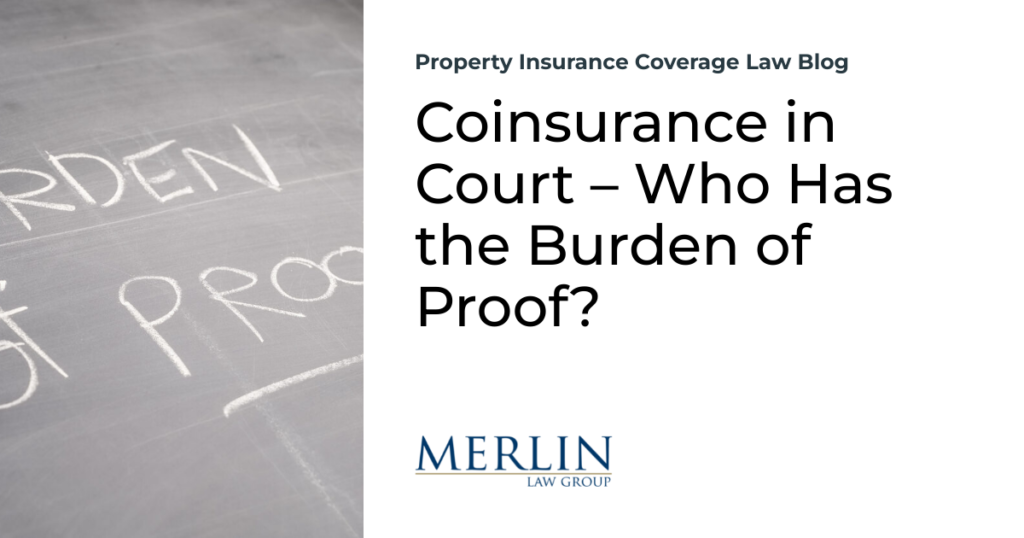Coinsurance in Court – Who Has the Burden of Proof?

Nobody likes coinsurance penalties.1 For policyholders, they can be unforeseen, confusing, and costly. For policyholder advocates, they can present a host of legal issues that are difficult and time-consuming to navigate. Some of those issues have been addressed on this blog, including the coinsurance clause enforcement, agent liability, and valuation disputes.
As a quick refresher, coinsurance clauses essentially impose a penalty on an insured for underinsuring their property. Failure to carry full or nearly full coverage results in the insured paying a percentage of the loss. In his 2011 blog post, Larry Bache explains: “[I]f a building valued at $250,000 is insured with a policy containing an 80% coinsurance clause, the policyholder must purchase at least $200,000 in coverage. If the policyholder purchased less than $200,000, he or she would be responsible for a proportionate share of the loss.”
Whether or not a coinsurance penalty applies hinges on the value of your property, which policyholders and their insurers often disagree on. When such a disagreement arises, who has the burden of proving the value of the property?
While there isn’t an abundance of law on the topic, it appears there’s a majority trend to treat coinsurance as an exclusion to coverage. This means that once the insured proves coverage exists under the policy, the burden of proof shifts to the insurer to prove the coinsurance clause is applicable. The Fifth Circuit has explained that this burden of proof on the insurer is a heavy one, stating coinsurance clauses “are entirely prohibited by statute in some jurisdictions, greatly restricted in others, and subject in all to a strict construction and the requirement of strict proof.”2 This means courts will scrutinize an insurer’s valuation to make sure it is clearly supported by the evidence. If it’s not, or even if the valuation dispute appears it could go either way, courts will err in favor of the policyholder. My state, Oklahoma, follows this rule, holding that “the insurer has the burden of showing that a loss falls within an exclusionary clause of the policy…[and,] in case of doubt, exclusions . . . are construed strictly against the insurer.”3 The same holds true in Texas (“A plea, the effect of which is to diminish an insured’s recovery and particularly the plea of co-insurance, is defensive and the facts supporting such a plea must be pled and proved by the defendant insurance company.”)4 and Florida (“If the insured succeeds in showing that the loss occurred within the policy period, then the burden shifts to the insurer to prove that a policy exclusion excepts the loss from coverage.”).5
Based on my initial research, Iowa,6 Kansas,7 Louisiana,8 Minnesota,9 and Virginia10 courts have also explicitly stated that insurers bear the burden of proving coinsurance clauses apply. Most other states appear to follow the rule that insurers bear the burden of proof when attempting to apply exclusions, and, therefore, would likely hold similarly regarding coinsurance clauses.
This rule seems fairly common sense – an insurer should not be able to rely on an arbitrary valuation to invoke a coinsurance clause and avoid full payment of a claim. However, we’ve seen just that, so it’s important to know who bears the burden of proof in that situation. If an insurer is trying to apply a coinsurance clause but can’t back up their valuation with clear and convincing proof, it seems most courts agree the clause does not apply. And, of course, should this happen to you or someone you are representing, the attorneys at Merlin Law Group are always here to help.
1 Except for insurance companies.
2 Home Ins. Co. v. Eisenson, 181 F.2d 416, 418-19 (5th Cir. 1950).
3 Country Mut. Ins. Co. v. AAA Constr. Ltd. Liab. Co., No. CIV-17-486, 2019 U.S. Dist. LEXIS 115935, at *6-7 (W.D. Okla. July 12, 2019) quoting Dodson v. St. Paul Ins. Co., 1991 OK 24, 812 P.2d 372, 377 (Okla. 1991) (internal quotations omitted).
4 Tex. City T. R. Co. v. Am. Equitable Assurance Co., 130 F. Supp. 843, 863 (S.D. Tex. 1955).
5 Transamerica Leasing, Inc. v. Inst. of London Underwriters, 267 F.3d 1303, 1305 (11th Cir. 2001) (interpreting Florida law).
6 Brown Twp. Mut. Ins. Asso. v. Kress, 330 N.W.2d 291, 297 (Iowa 1983).
7 Wenrich v. Emplrs Mut. Ins. Cos., 35 Kan. App. 2d 582, 585, 132 P.3d 970, 974 (2006).
8 Doerr v. Mobil Oil Corp., 774 So.2d 119, 124 (La.2000); Mt. Hawley Ins. Co. v. Advance Prods. & Sys., Inc., 972 F. Supp. 2d 900 (W.D. La. 2013) (reversed on different grounds).
9 Anderson v. Conn. Fire Ins. Co., 231 Minn. 469, 478, 43 N.W.2d 807, 813-14 (1950); Reinsurance Asso. of Minn. v. Patch, 383 N.W.2d 708, 711 (Minn. Ct. App. 1986).
10 Harper v. Penn Mut. Fire Ins. Co., 199 F. Supp. 663, 665 (E.D. Va. 1961).







